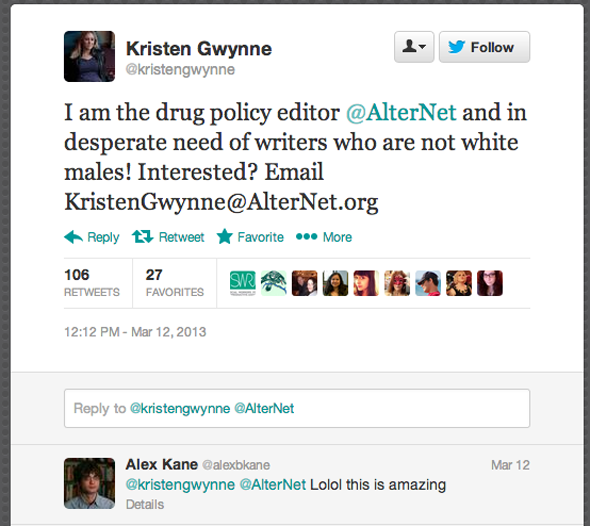VIDA’s third annual survey of female representation at several prominent print publications — “The Count” — was released on March 4. For the third year in the row, the number of male bylines and works by male writers reviewed vastly outnumbered those of women almost across the board, and a look at all data from all three years indicated that things haven’t improved over time (in fact, at several publications, the percentage of women represented decreased between 2011 and 2012). In previous years, VIDA demanded better from those publications. This time, it seemed to meet the results with a resigned sigh.
“As always, the charts tell their own stories, whether publishers and editors listen or not. And now their histories are showing,” wrote Amy King, calling out Harpers, The Nation, The New Republic, New York Review of Books, The Paris Review, and the Times Literary Supplement for “their gross (& indecent) neglect of female writers’ work.”
VIDA numbers echoed those in the Women’s Media Center’s recent report on gender disparity in American media, which WMC said was at “crisis levels.”
“The facts cannot be denied; little has changed,” Jen Fitzgerald, VIDA’s count director, told CJR in an email.
Looking at those numbers and charts, that certainly appears to be so. VIDA’s frustration is understandable. But there are other signs that things are starting to change and more publications are making real efforts to diversify bylines.
For Tin House editor Rob Spillman, VIDA’s count was the impetus to make a change. This year, the quarterly literary magazine was one of the few publications VIDA singled out for praise. As Spillman told Flavorwire’s Emily Temple, because his staff was equally comprised of men and women, “We thought we were gender-blind. However, the numbers didn’t bear this out.”
Tin House did some research and found that it received more submissions from men than women by about 2:1. On top of that, men whose pitches were rejected were five times more likely to pitch again than women. That leaves Tin House with far fewer reliable, regular female freelancers. The editors who are content to sit and wait for the pitches to come to them and to draw from the same stable of writers for every issue will continue to see unequal representation in their publications year after year.
The New Republic’s online book review editor, Chloe Schama, noticed similar trends. Men “pitch with a much greater frequency” than women, she said, which can put the onus on the editor to reach out to female writers and ensure that both genders are equally represented. Frankly, not all editors have the time, desire, or ability to do that.
Incidentally: It should be noted that because VIDA only counts print publications, Schama’s efforts were not reflected in the The New Republic’s tally. Jen Fitzgerald explained the reasoning behind this: “The internet is fluid; content appears, disappears and changes. Also, appearing in print holds more weight professionally than appearing online.”
That’s too bad, as Schama said the ratio of male to female bylines since she began her position last summer is much closer to parity than bylines in the print publication (where, according to VIDA, of 88 book reviewers in 2012, just nine were women). “There is more hope in the digital space than those numbers would indicate,” Schama said.
Again, that’s as long as there are editors who, like Schama and Spillman, make the effort to find and cultivate new talent that is representative of the population. Rachel Sklar, co-founder of Change the Ratio and TheLi.st, two organizations that work to increase female visibility and representation in the media, said many editors’ “default settings” when looking for writers “favor networks of white dudes.”
“Changing defaults requires effort and requires prioritizing,” she continued, but it’s also “legitimately great for the bottom line.” And there’s the “added bonus that people like me will stop bugging them.”
So:
If you’re a female writer looking for work: pitch! Pitch like Geena Davis’s sister in A League of Their Own. And if a publication turns you down, pitch something else.
If you’re a reader, let magazines know that byline diversity is important to you. As Fitzgerald wrote: “If readers feel that a periodical should be lauded for their efforts, drop them a line. If readers are disheartened by little/no improvement or backwards sliding, we encourage them to let the editors know that their interests are not being represented in the journals they subscribe to. We each control where and how our money is spent.”
If you’re an editor, keep looking for those new voices to build up a roster of talent that is inclusive and accurately reflects our population.
Just don’t do it like this:



 Archives:
Archives: